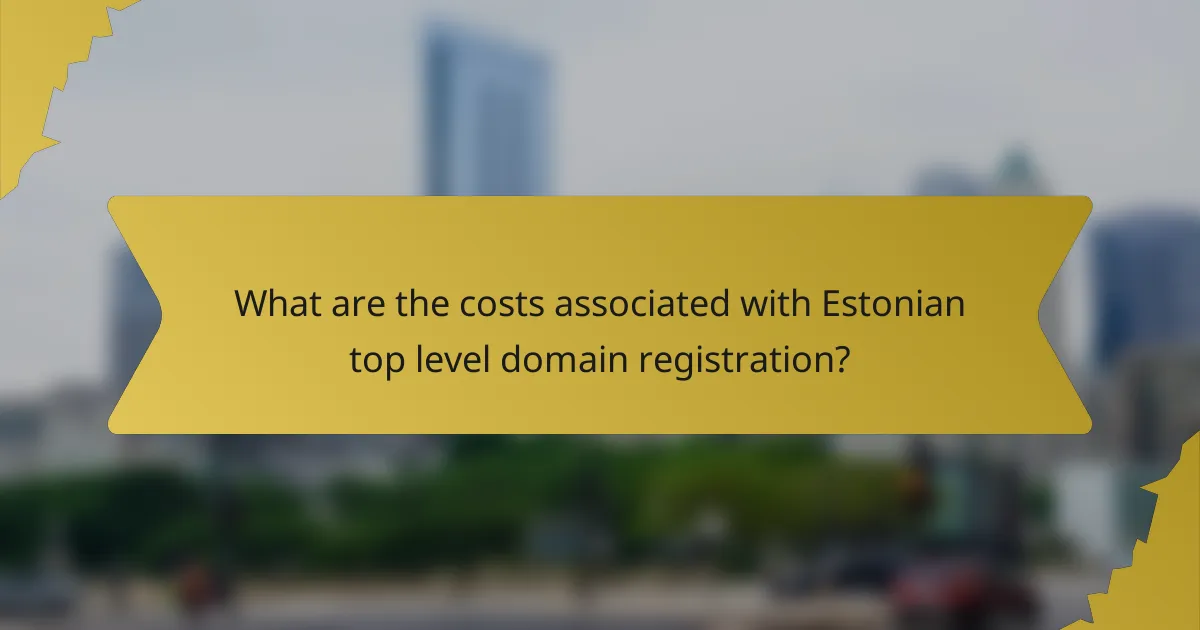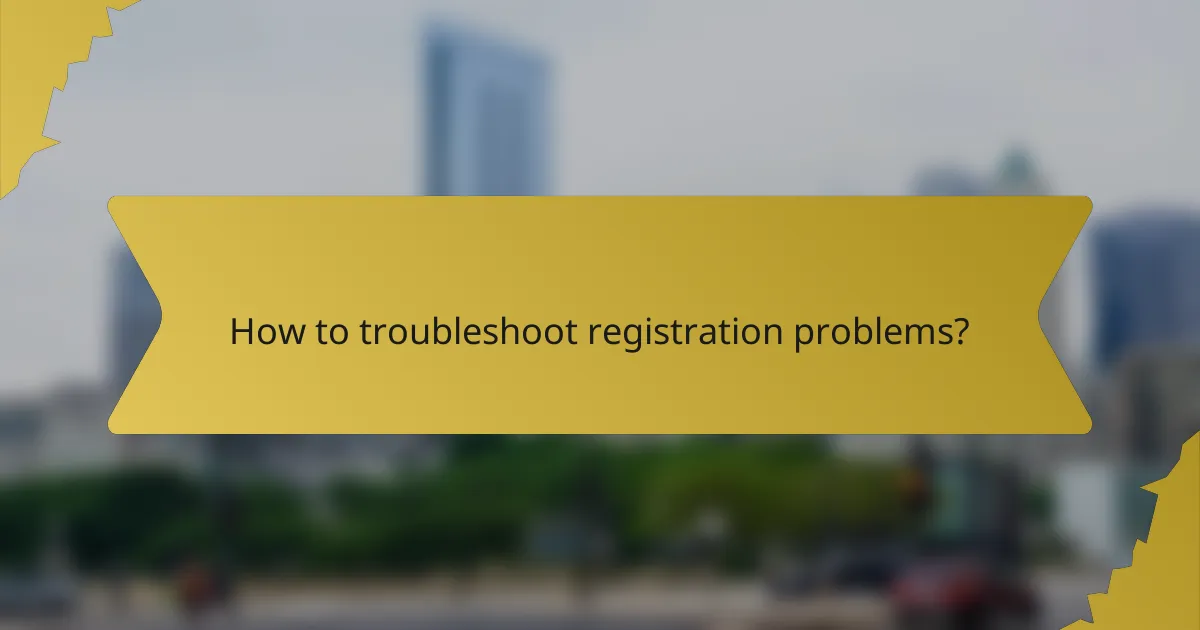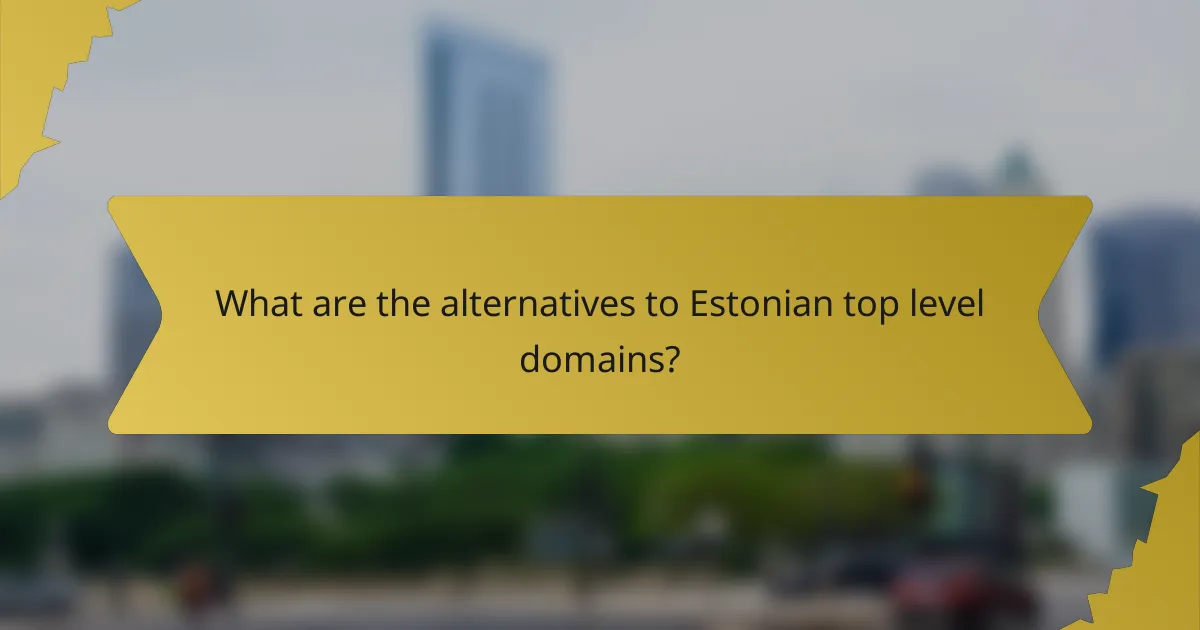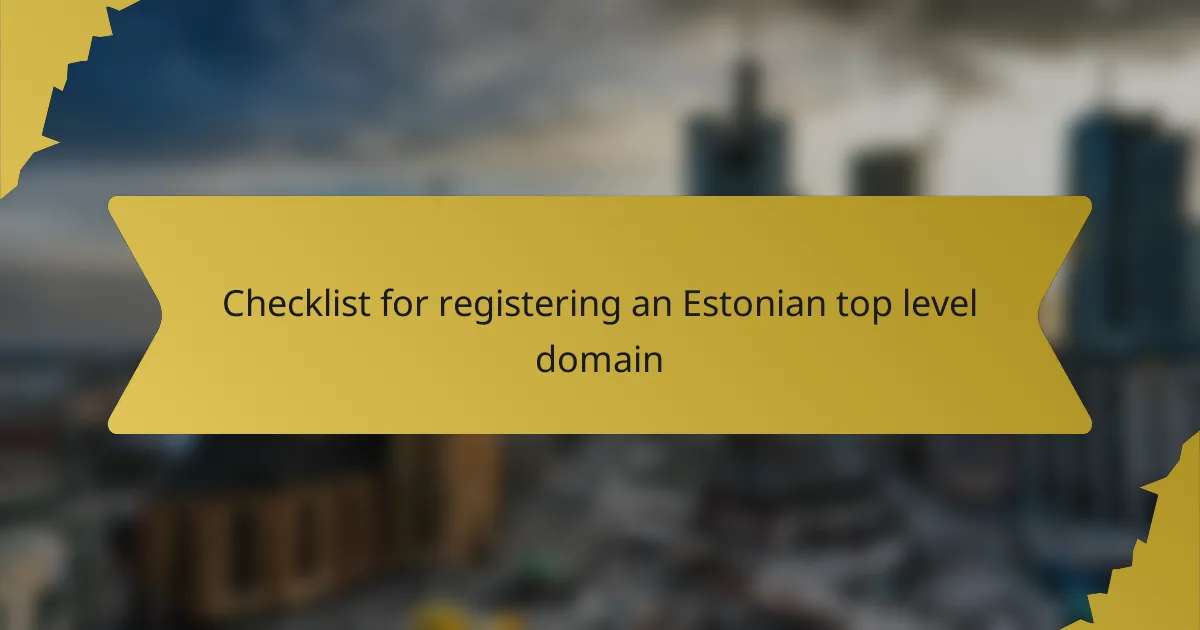Registering an Estonian top-level domain involves a series of essential steps, including selecting a registrar, submitting required documentation, and confirming ownership. To qualify, you must meet specific criteria, such as having valid identification and a local presence in Estonia. Additionally, it’s important to be aware of the initial registration fees and ongoing renewal costs to effectively manage your domain.

What are the steps to register an Estonian top level domain?
To register an Estonian top level domain, you need to follow a series of straightforward steps that include selecting a registrar, providing documentation, filling out a registration form, paying the fee, and confirming ownership. Each step is essential to ensure that your domain is properly registered and legally yours.
Choose a domain registrar
The first step in registering an Estonian top level domain is to choose a domain registrar accredited by the Estonian Internet Foundation. Look for registrars that offer competitive pricing, good customer support, and user-friendly interfaces. Popular options include Zone, Veebimajutus, and EuroDNS.
Consider the services offered by the registrar, such as domain management tools, privacy protection, and additional hosting services. Reading customer reviews can also help you make an informed decision.
Provide necessary documentation
When registering an Estonian top level domain, you must provide certain documentation to verify your identity and eligibility. This typically includes a valid ID for individuals or a business registration certificate for companies. Ensure that all documents are current and clearly legible.
If you are a foreign entity, you may need to provide additional information, such as proof of a local presence or a representative in Estonia. Check with your chosen registrar for specific requirements.
Complete the registration form
After gathering the necessary documentation, you will need to fill out the registration form provided by your chosen registrar. This form will require you to enter your desired domain name, personal or business details, and contact information.
Make sure to double-check the spelling of your domain name and all entered information to avoid any errors that could delay the registration process. Some registrars may offer suggestions for available domain names if your first choice is taken.
Pay the registration fee
Once you have completed the registration form, the next step is to pay the registration fee. Fees for Estonian top level domains typically range from €10 to €30 per year, depending on the registrar and any additional services you choose.
Payment methods may vary by registrar, so check for options such as credit card, PayPal, or bank transfer. Keep a record of your payment confirmation for future reference.
Confirm domain ownership
After payment, you will receive a confirmation email to verify your domain ownership. It is crucial to follow the instructions in this email to complete the registration process. Failure to confirm may result in the domain being released back to the registrar.
Once confirmed, you will have full control over your domain. Regularly check your registration status and keep your contact information up to date to avoid any issues in the future.

What are the requirements for registering an Estonian top level domain?
To register an Estonian top-level domain (TLD), you must meet specific criteria, including valid identification and a local presence in Estonia. These requirements ensure that domain registrations are legitimate and traceable.
Valid identification
Valid identification is crucial for registering an Estonian TLD. You will need to provide a government-issued ID, such as a passport or national ID card, to verify your identity. This step helps prevent fraudulent registrations and ensures accountability.
In some cases, you may also be required to submit additional documentation, such as proof of address or business registration, especially if you are registering on behalf of a company. Ensure that all documents are current and clearly legible to avoid delays in the registration process.
Local presence in Estonia
Having a local presence in Estonia is another key requirement for registering an Estonian TLD. This means that either you or your organization must have a physical address in Estonia. This local presence is necessary for the domain registration to be valid and recognized.
If you do not have a physical presence in Estonia, consider using a local service provider or a domain registration company that can act as your representative. This option allows you to comply with the local presence requirement while still managing your domain effectively from abroad.

What are the costs associated with Estonian top level domain registration?
The costs for registering an Estonian top level domain (TLD) typically include initial registration fees and ongoing renewal costs. Understanding these expenses is crucial for budgeting and maintaining your domain over time.
Registration fees
Registration fees for an Estonian top level domain can vary based on the registrar you choose and the specific domain extension. Generally, these fees range from approximately €10 to €30 for a standard domain name.
When selecting a registrar, consider any additional services they may offer, such as privacy protection or web hosting, which can affect the overall cost. It’s advisable to compare several registrars to find the best deal that meets your needs.
Renewal costs
Renewal costs for Estonian top level domains are usually similar to the initial registration fees, typically falling within the same range of €10 to €30 per year. It’s important to be aware that some registrars may increase their renewal fees after the first year.
To avoid unexpected charges, check the renewal policy of your chosen registrar before completing your registration. Setting reminders for renewal dates can help ensure that you maintain ownership of your domain without interruption.

What are the benefits of registering an Estonian top level domain?
Registering an Estonian top level domain (TLD) offers several advantages, including increased trust among local customers and easier access to European markets. Businesses can enhance their online presence and credibility by using a domain that reflects their Estonian identity.
Enhanced credibility
An Estonian top level domain can significantly boost your business’s credibility, especially among local consumers. Using a .ee domain signals that your business is established in Estonia, which can foster trust and encourage customer engagement.
Additionally, having a local TLD can improve your search engine rankings within Estonia. This means that potential customers are more likely to find your website when searching for relevant products or services.
Access to EU markets
Registering an Estonian TLD provides businesses with easier access to the broader European Union market. Estonia’s membership in the EU allows companies to operate seamlessly across member states, benefiting from a single market without trade barriers.
Moreover, an Estonian domain can help businesses comply with EU regulations, which may be advantageous for companies looking to expand their operations. This compliance can include data protection laws and e-commerce regulations, making it easier to build trust with customers across Europe.

What are the common issues faced during registration?
Common issues during the registration of an Estonian top-level domain include documentation errors and payment processing delays. Addressing these challenges promptly can help ensure a smoother registration experience.
Documentation errors
Documentation errors often arise from incomplete or incorrect submissions, which can lead to delays or rejection of your application. Ensure that all required documents, such as proof of identity and business registration, are accurate and up-to-date.
Double-check the specific requirements for the domain type you are registering, as these can vary. For instance, a .ee domain may require a local presence or a registered business in Estonia, while other domains may have different stipulations.
Payment processing delays
Payment processing delays can occur due to various factors, including issues with the payment method or bank processing times. Using a widely accepted payment method, such as credit cards or PayPal, can help mitigate these delays.
Be aware of potential currency conversion fees if you are paying from outside the Eurozone. Always confirm that your payment has been processed successfully before proceeding with the registration to avoid unnecessary complications.

How to troubleshoot registration problems?
If you encounter issues while registering an Estonian top-level domain, start by identifying the specific problem and follow a systematic approach to resolve it. Common issues include compliance with registration requirements and technical difficulties with the registrar’s platform.
Contact domain registrar support
The first step in troubleshooting is to reach out to your domain registrar’s customer support. They can provide insights into any technical issues or account-related problems that may be hindering your registration process.
When contacting support, be prepared to provide details about your registration attempt, including any error messages you received. This information will help them assist you more effectively.
Check for compliance with requirements
Ensure that you meet all the necessary requirements for registering an Estonian top-level domain. This includes having a valid identification document and, in some cases, a local presence in Estonia.
Review the specific eligibility criteria set by the registrar, as these can vary. Common requirements may include proof of business registration or a local address, so double-check that you have all necessary documentation ready.

What are the alternatives to Estonian top level domains?
Alternatives to Estonian top level domains (TLDs) include various country-specific domains from other European nations. Each country has its own domain registration rules, pricing, and intended use, which can influence your choice based on your target audience or business strategy.
Other European country domains
Many European countries offer their own TLDs, which can be beneficial for businesses targeting specific markets. For instance, .de is the TLD for Germany, .fr for France, and .co.uk for the United Kingdom. These domains can enhance local credibility and improve search engine visibility in those regions.
When considering other European TLDs, it’s essential to understand the registration requirements. Some countries may require a local presence or specific documentation, while others are more accessible. For example, .fr domains require a local administrative contact, whereas .de domains can be registered by anyone.
Pricing for these TLDs varies widely. Generally, you can expect to pay anywhere from €10 to €50 per year, depending on the domain and registrar. It’s advisable to compare different registrars for the best deals and services, as some may offer additional features like privacy protection or web hosting.
